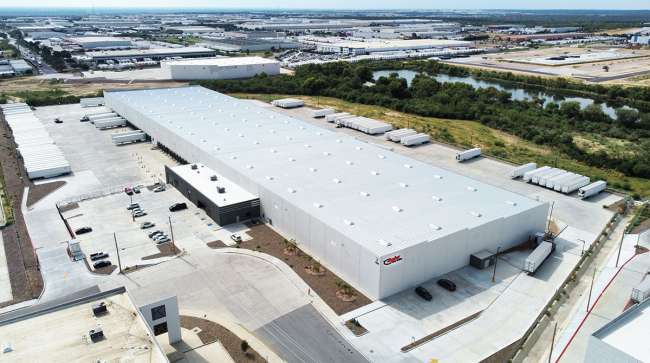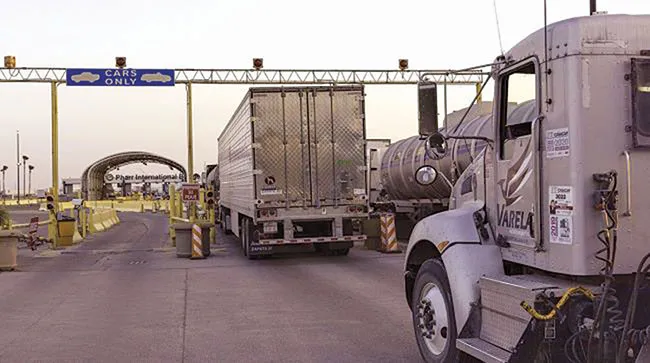Staff Reporter
Nearshoring Trend Drives More Border Growth

[Stay on top of transportation news: Get TTNews in your inbox.]
The nearshoring trend has been driving further transportation and logistics investments near the Mexican border as companies work to capture current and expected future growth.
Nearshoring is the process of companies moving offshore operations to neighboring countries. Mexico has been a main focus of the trend with the country providing skilled but comparatively cheaper labor. U.S. Census Bureau data shows it is the top importer at 14.8%.
“Overall, nearshoring has been pivotal for cross-border transportation — with Mexico ranked as the top U.S. trading partner in 2023,” said Ben Enriquez, head of Mexico logistics and customs at Uber Freight. “The nearshoring boom has continued to positively impact the Mexican economy and the market has favored shippers. Many companies are moving or enhancing their operations in Mexico.”
Uber Freight data found these companies moving into Mexico or bolstering their operations account for $106 billion and 235,000 in new direct employments over the next few years. This marks a 21% increase in foreign direct investment from last year.

Trucks bound for Mexico wait at the Pharr Port of Entry in Texas. (Michael Gonzalez/Getty Images via Bloomberg News)
“It’s only expected to grow further moving forward,” Enriquez said. “In fact, nearshoring is estimated to generate demand for up to 8 million square meters in industrial spaces in Mexico by 2027. As more companies migrate to Mexico, there will be a growing need for increased capacity to ship to the U.S., posing a challenge for shippers and impacting rates. Right now, shippers should be negotiating and locking in rates for 2024 in this soft market where carriers are prioritizing long-term commitments at competitive rates.”
Ryder System is one such company working to grow its operations on the border to meet the nearshoring demand. The supply chain and fleet management solutions provider announced Feb. 21 the opening of a new 228,000-square-foot multiclient warehouse and cross dock in the critical trade hub of Laredo, Texas. The company also said it expanded its drayage yard in Nuevo Laredo, Mexico. It has already maxed out its other border facilities with the trend growing.
Ryder ranks No. 9 on the Transport Topics Top 100 list of the largest for-hire carriers in North America and No. 10 on the TT Top 100 logistics companies list.
Get the inside scoop on ATA's Technology & Maintenance Council Annual Meeting March 4-7 in New Orleans. Tune in above or by going to RoadSigns.ttnews.com.
“We really had to in order to support continued growth with our customers and to fulfill their needs,” said Frank Bateman, vice president of supply chain operations for Ryder. “Besides the fact that some of them are currently doing that, a lot of them have plans to do that in the future. As that happens, the traffic and everything is going to continue to grow over time. The government has actually put some investments into the ports of Laredo.”
Bateman stressed the importance of ensuring the current needs of customers are met with these border expansions. He noted that customers already have been crossing through the port of Laredo with some of them seeing their volumes increase. But he also sees the nearshoring trend growing even more in the future.
“It really is a hub as far as the deconsolidation, consolidation and coordinating with customs brokers in order to have those counts so that they can ensure they do the documentation with either the U.S. customs broker or the Mexico customs broker,” Bateman said. “It also has a yard so that we can have the drop-and-hook between the U.S. drivers and the Mexico drivers.”
Bateman noted nearshoring has been evolving and will continue to evolve because companies are trying to mitigate their risks amid geopolitical uncertainties. He pointed to the Russo-Ukrainian War and China. But he also noted factors like weather play a role as well as the desire to decrease lead times for shipments and decrease the length of supply chains.
“In Q4, RXO saw a 28% year-over-year increase in cross-border activity, showing the investment companies continue to make in nearshoring,” said Demetri Venetis, president of freight forwarding at RXO. “At the beginning of the year, new regulations rolled out on the Mexico side, increasing the time to cross the border. As stakeholders have gotten used to the new regulations, we’ve seen the delays lessen, but we’ve been working closely with our customers to increase alerts and communication about any potential disruptions.”
Want more news? Listen to today's daily briefing above or go here for more info
Redwood Logistics announced a plan to expand its operations in Mexico in response to the nearshoring trend in April 2023. It has continued to increase its investments in the country, with the company now reporting that its new offices are almost filled in Monterrey, Mexico.
Redwood Logistics ranks No. 52 on the TT100 logistics list.
“We are experiencing year-over-year growth in our Mexico operations fueled by both new customer acquisition and continued growth from existing customers,” said Jordan Dewart, president of Redwood Mexico. “Thankfully our customer’s industry penetration is quite diversified so we are seeing growth in multiple arenas such as health care, food and beverage, manufacturing, automotive and fast-moving commercial goods.”
Dewart believes that the nearshoring trend isn’t going as fast as had been predicted. He noted that while foreign direct investments and plant expansions have been widely announced in the last few years, those investments are just now coming on line. He noted that growth in Mexico is dependent on a resurgence of the U.S. economy, increased demand and more deglobalization.



